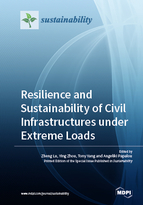Resilience and Sustainability of Civil Infrastructures under Extreme Loads
A special issue of Sustainability (ISSN 2071-1050). This special issue belongs to the section "Energy Sustainability".
Deadline for manuscript submissions: closed (31 March 2019) | Viewed by 75131
Special Issue Editors
Interests: structural control; seismic design of building structures; renewable energy
Special Issues, Collections and Topics in MDPI journals
Interests: seismic performance of complex tall buildings; performance-based seismic design; structural performance of composite structures and hybrid structures; methodology and technology for structural dynamic test
Special Issues, Collections and Topics in MDPI journals
Interests: seismic behaviour and design of steel; concrete and composite structures; seismic behaviour and design of tall buildings; development of performance-based evaluation methodology and code design procedures for new and existing structures; energy dissipation systems
Special Issues, Collections and Topics in MDPI journals
Interests: structural vibration control; particle damping technology; passive control
Special Issues, Collections and Topics in MDPI journals
Special Issue Information
Dear Colleagues,
There are many regions worldwide that are susceptible to extreme loads, such as earthquakes, typhoon, tsunami, landslides, debris flow, etc., which cause loss of life and adverse impacts to civil infrastructure, the environment and to communities. A series of methods and measures have been used to mitigate the effects of these extreme loads. The adopted approaches and methods must be sustainable and resilient, and resilient civil infrastructures are one of the important methods. To reduce damage and downtime in addition to protecting life safety, the new resilient building technologies are developed.
This Special Issue focuses on methods to enhance the sustainability and resilience of civil infrastructures in the event of extreme loads (earthquakes, typhoon, tsunami, landslides, debris flows, etc.). This Special Issue is expected to contribute to the proposal of new and resilient building structures and their experimental and theoretical research, and will play a certain role in promoting the application of new recoverable buildings. Expected topics include, but are not limited to, theoretical and experimental research on new structural forms for extreme loads, such as earthquakes, typhoon, tsunami, landslides and landslides, their experimental and theoretical studies, examples or case studies of implemented low-damage structural systems in buildings, development of design philosophies and performance criteria for resilient design of buildings and new sustainable communities, etc.
Prof. Dr. Zheng LuProf. Dr. Ying Zhou
Assoc. Prof. Dr. Tony Yang
Assoc. Prof. Dr. Angeliki Papalou
Guest Editors
Manuscript Submission Information
Manuscripts should be submitted online at www.mdpi.com by registering and logging in to this website. Once you are registered, click here to go to the submission form. Manuscripts can be submitted until the deadline. All submissions that pass pre-check are peer-reviewed. Accepted papers will be published continuously in the journal (as soon as accepted) and will be listed together on the special issue website. Research articles, review articles as well as short communications are invited. For planned papers, a title and short abstract (about 100 words) can be sent to the Editorial Office for announcement on this website.
Submitted manuscripts should not have been published previously, nor be under consideration for publication elsewhere (except conference proceedings papers). All manuscripts are thoroughly refereed through a single-blind peer-review process. A guide for authors and other relevant information for submission of manuscripts is available on the Instructions for Authors page. Sustainability is an international peer-reviewed open access semimonthly journal published by MDPI.
Please visit the Instructions for Authors page before submitting a manuscript. The Article Processing Charge (APC) for publication in this open access journal is 2400 CHF (Swiss Francs). Submitted papers should be well formatted and use good English. Authors may use MDPI's English editing service prior to publication or during author revisions.
Keywords
- Resilience and sustainability
- Civil infrastructures
- Extreme loads
- New structure or components
- Loss assessment and analytical studies
- Earthquake-resilient buildings or communities
- Typhoon-resilient buildings or communities
- Tsunami-resilient buildings or communities
- Landslide-resilient buildings or communities
- Mudslide-resilient buildings or communities







